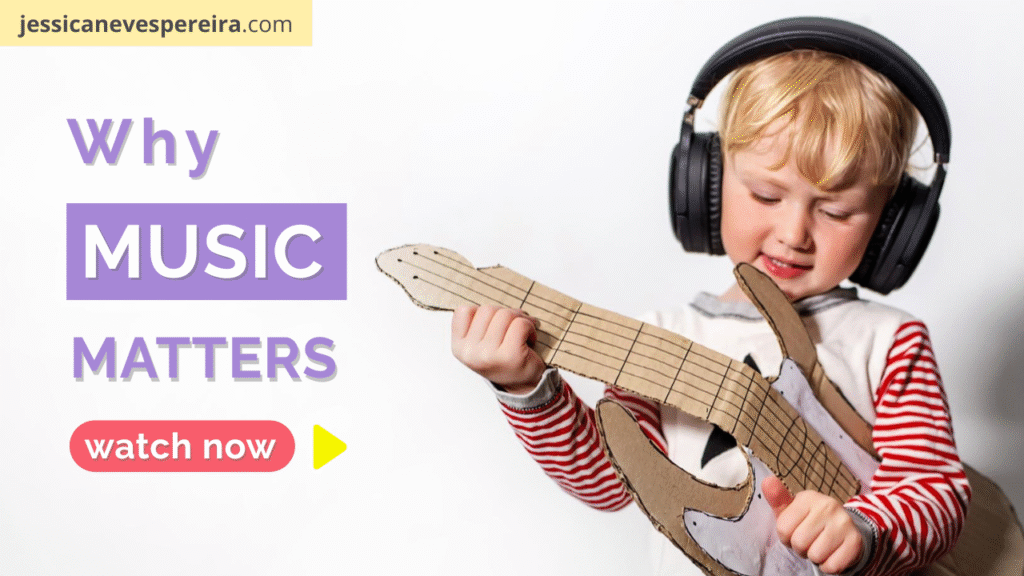Music benefits for children begin as early as infancy. From soothing sounds to interactive rhythms, music isn’t just play — it’s a powerful tool for development.
Let’s explore how music influences the brain, body and emotions of children by age group — and discover the best musical toys of 2025 to nurture their development.
🛒 Quick Pick: Baby Einstein Take Along Tunes Musical Toy – Amazon — ideal for infants exploring sound and rhythm from their very first months.
Decades of research in child psychology and early education confirm that music supports neural plasticity, emotion regulation, motor coordination, and language development. Whether it’s through lullabies, singing games, clapping rhythms or instruments, music stimulates both hemispheres of the brain.
Parents, caregivers and educators can harness music in daily routines: singing during diaper changes, playing rhythmic games during transitions, offering musical instruments during playtime, or using music for emotional soothing and focus. These strategies not only foster cognitive and emotional growth but also strengthen the adult-child bond.
Babies (0–2 years): Music Begins with Bonding
Key Benefits:
- Emotional regulation (soothing through lullabies)
- Sensory development (sound, touch, rhythm)
- Early language processing (melodic speech patterns)
- Parent-child bonding and early trust building
How to Encourage Music at This Stage:
- Sing lullabies or hum softly during feeding and bedtime routines
- Gently sway or bounce the baby to music to develop vestibular sense
- Use rattles or toys that create soft tones to attract auditory attention
Top Toys in 2025:
- Baby Einstein Take Along Tunes Musical Toy
Boosts auditory recognition and emotional calm. - Fisher-Price Laugh & Learn Music Player
Introduces cause-and-effect through interactive buttons. - Montessori Wooden Xylophone Baby Toy (Amazon)
Encourages fine motor control and sound exploration.
Toddlers (3–5 years): Building Patterns, Words & Movement
Key Benefits:
- Improves speech and vocabulary through singing
- Enhances memory, sequencing and rhythm
- Develops gross and fine motor skills through dancing & drumming
- Strengthens self-expression and confidence
How to Encourage Music at This Stage:
- Introduce call-and-response songs to develop language processing
- Dance together using scarves or ribbons to explore tempo and expression
- Create rhythm games with household objects (pots, wooden spoons)
Top Toys in 2025:
- LeapFrog Learn & Groove Musical Table
Introduces ABCs, numbers, and music notes through interactive surfaces. - Melissa & Doug Band-in-a-Box Set
Boosts coordination, sound identification and creative group play. - VTech KidiBeats Drum Set
Promotes rhythmic skills and listening focus.
Children (6–8 years): Creative Expansion & Social Connection
Key Benefits:
- Enhances reading and math via rhythm and pattern recognition
- Develops emotional nuance through musical storytelling
- Supports teamwork and social skills in group music play
How to Encourage Music at This Stage:
- Enroll children in beginner music classes (e.g. keyboard, recorder, ukulele)
- Encourage singing along with storybooks or favorite shows
- Use songs with verses to support memory and sequencing
Top Toys in 2025:
- Casio SA-51 Keyboard for Kids
Builds hand-eye coordination and musical exploration. - KidiStar DJ Mixer by VTech
Sparks creativity, timing and musical sequencing. - Ukulele Starter Kit (colorful 4-string beginner version)
Fosters discipline, musical memory and melody creation.
📘 Related Reading: Best Instruments by Age in 2025
Preteens (9–11 years): Mastery, Emotion & Identity
Key Benefits:
- Refines focus, perseverance and memory through music practice
- Deepens emotional intelligence and stress release
- Encourages personal expression and musical identity
How to Encourage Music at This Stage:
- Offer opportunities for performance (e.g. family concerts, talent shows)
- Use songwriting or journaling combined with music to process feelings
- Encourage exploration of digital tools (e.g. recording apps, mixing tools)
Top Toys/Tools in 2025:
- Yamaha PSS-A50 Portable Keyboard
Ideal for melody, chords and songwriting basics. - BONAOK Wireless Karaoke Microphone
Boosts self-confidence and performance readiness.
Music Sparks Growth at Every Age
Whether through lullabies, dancing, or songwriting, music connects us deeply to ourselves and each other. The right toy can be the spark that ignites a lifelong passion or simply gives your child the confidence to explore sound, emotion and movement.
🧠 Remember: When adults actively participate — singing, moving, and listening alongside children — the developmental benefits of music multiply. You don’t have to be a professional musician; just be present and playful.
🎧 Which musical toy has made a difference in your child’s life? Share your favorite in the comments!






